Identification
Squash bees (Eucera (Peponapis) pruinosa) occur throughout much of the United States and Mexico, where they are important pollinators of plants in the genus Cucurbita. This includes summer squash, winter squash, zucchini, pumpkins, and many gourds (but not cucumbers). Indeed, squash bees are most easily recognized by their behavior of visiting these flowers starting around sunrise, before other bees are active.
Squash bees could be confused with honey bees, which they resemble in general size and coloration. In comparison, however, squash bees are larger, bulkier and have longer antennae and rounder faces. In females, the hind legs are another distinguishing feature. Worker honey bees have smooth, flat hind legs onto which they pack compact balls of pollen, while female squash bees have very fuzzy hind legs which may be covered all over in loose pollen.
Male and female squash bees can be distinguished by the presence of extensive fuzzy, pollen-carrying hairs on the hind legs of the female (males do not carry pollen), and a yellow spot on the face of the male (females’ faces are entirely dark).
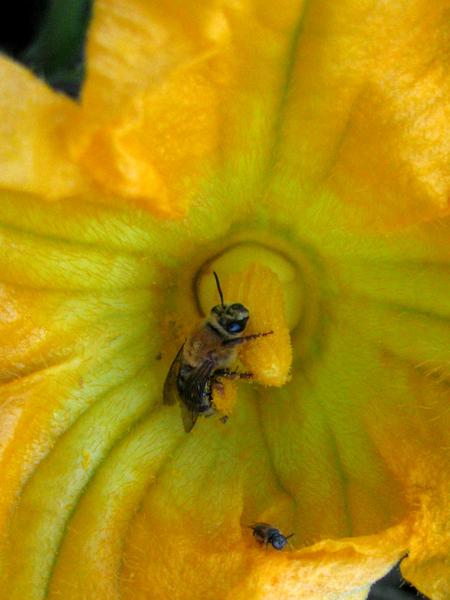
Female squash bee in a pumpkin flower. Note the pollen covering her hind legs.
Elsa Youngsteadt CC BY-NC 4.0
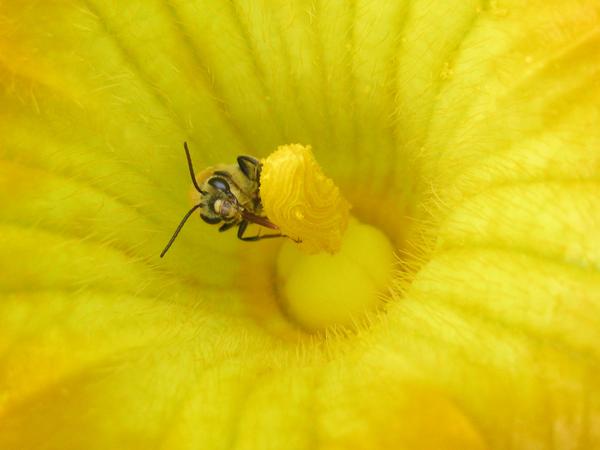
Male squash bee in a pumpkin flower. The yellow spot on the face identifies this bee as a male.
Elsa Youngsteadt CC BY-NC 4.0
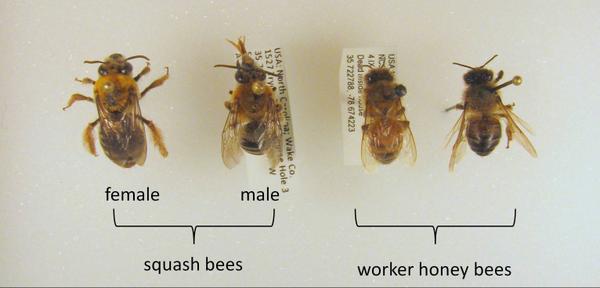
Comparison of squash bees and honey bees. Note the larger size and bulkier build of the squash bees.
Elsa Youngsteadt CC BY-NC 4.0
Biology
Squash bees, like most of our native bees, are solitary, ground-nesting bees. This means that they do not live in a hive or colony like the more familiar honey bees and bumble bees. Instead, each female squash bee digs her own nest in the soil and collects pollen and nectar to feed her own offspring. In North Carolina, adults are active in mid summer (June to August). Throughout the rest of the year, squash bees are present underground, developing within the nest cells constructed by the mother bee.
Squash bees gather pollen exclusively from plants in the genus Cucurbita. These flowers open near dawn, and squash bees begin foraging around the same time. They continue visiting the flowers until they wilt around mid day. It takes only 6 to 10 squash-bee visits to fully pollinate a female squash flower. Squash bees can typically pollinate a plant (or a field of plants) before other bees have even begun foraging for the day. Although honey bees and bumble bees can be effective pollinators for squash, they are superfluous in the presence of squash bees.
Economic Importance
Squash yield is entirely dependent on insect pollinators, because male and female reproductive parts are housed in separate flowers. The pollen is heavy and can’t be dispersed by wind. By some estimates, squash bees alone may pollinate around two-thirds of the commercially grown squash in the United States. They are also regular visitors to suburban vegetable gardens.
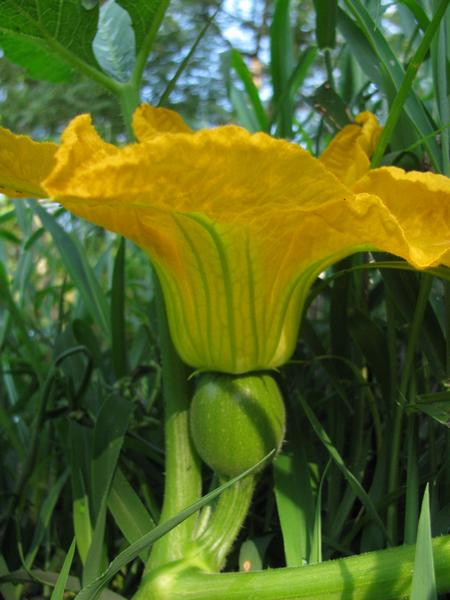
This female flower won't develop into a pumpkin unless an insect visitor leaves behind some pollen to fertilize it.
Elsa Youngsteadt CC BY-NC 4.0
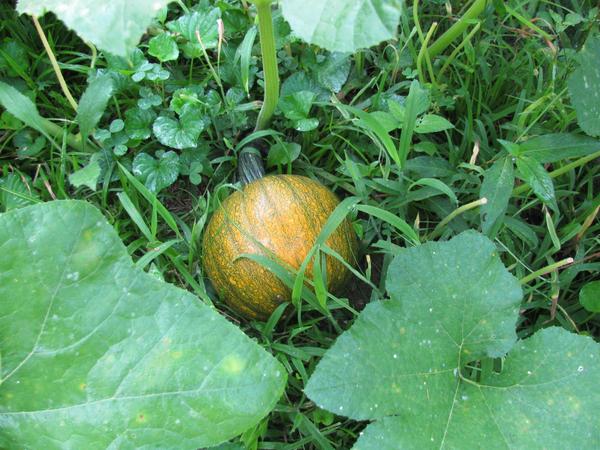
Up to 2/3 of the pumpkins, gourds, and squash grown in the US may be pollinated by squash bees.
Elsa Youngsteadt CC BY-NC 4.0
Conservation
Because squash bees nest in the ground, often right under the squash plants, they may be sensitive to soil disturbance. The female bees usually build their nest cells 6 to 12 inches underground, and the next generation of bees spends most of the year sealed inside those cells.
Tilling a squash bed at any time of year has the potential to destroy squash bees. A census of 25 squash and pumpkin farms in Maryland, Virginia, and West Virginia found three times more squash bees on no-till farms than on those that tilled. However, a second study, in 20 pumpkin farms in Maryland and Virginia, found no such effect and suggested that bees may disperse from safe sites to tilled sites by the time pumpkins bloom, relatively late in the season.
Other soil treatments may also affect squash bees. One study found that the bees were more common on irrigated farms, perhaps because moist soils are easier for squash bees to excavate during nest construction. Another study found that squash bees can dig through a modest, 2-inch layer of mulch to make their nests, although this was based on a limited sample of 4 nests.
Finally, to conserve squash bees, be aware of pesticides in the garden. Squash plants get some pests—such as cucumber beetles and squash vine borers—that may require intervention. If you treat a flowering squash plant with insecticide, proceed with caution; some insecticides should not be used at all in this situation, and others only in the evening when bees are not active. Also bear in mind that systemic insecticides applied before flowering can still be present at toxic levels in squash pollen. (The North Carolina Agricultural Chemicals Manual does not list any systemic insecticides for control of squash pests in home gardens.) As always, check the pesticide label for any pollinator-specific warnings, and follow all label directions.
The immature bees in underground nest cells can be exposed to chemicals that are applied to the soil at any time of year. Adults are also exposed to any insecticides in the soil when they dig their nests. One study found an 89% reduction in reproductive success of squash bees in plots where squash were treated with the systemic insecticide imidacloprid via soil drench.
Sources and Further Reading
Video about the squash bee life cycle
Slide show from the USDA about squash bees as pollinators
Artz, DR, and BA Nault. 2011. Performance of Apis mellifera, Bombus impatiens, and Peponapis pruinosa (Hymenoptera: Apidae) as pollinators of pumpkin. Journal of Economic Entomology 104:1153-1161.
Cane, JH, BJ Sampson, and SA Miller. 2011. Pollination value of male bees: the specialist bee Peponapis pruinosa (Apidae) at summer squash (Cucurbita pepo). Environmental Entomology 40:614-620.
Dively, GP, and A Kamel. 2012. Insecticide residues in pollen and nectar of a cucurbit crop and their potential exposure to pollinators. Journal of Agricultural and Food Chemistry, 60:4449-4456.
Hinners SJ, CA Kearns, and CA Wessman. 2012. Roles of scale, matrix, and native habitat in supporting a diverse suburban pollinator assemblage. Ecological Applications 22:1923-1935.
Julier, HE, and TH Roulston. 2009. Wild bee abundance and pollination service in cultivated pumpkins: farm management, nesting behavior and landscape effects. Journal of Economic Entomology 102:563-573.
Mathewson, JA. 1968. Nest construction and life history of the eastern cucurbit bee, Peponapis pruinosa (Hymenoptera: Apoidea). Journal of the Kansas Entomological Society 41:255-261.
Shuler, RE, TH Roulston, and GE Farris. 2005. Farming practices influence wild pollinator populations on squash and pumpkin. Journal of Economic Entomology 98:790-795.
Splawski, CE, et al. 2014. Mulch effects on floral resources and fruit production of squash, and on pollination and nesting by squash bees. HortTechnology 24:535-545.
Stoner KA, and BD Eitzer. 2012. Movement of soil-applied imidacloprid and thiamethoxam into nectar and pollen of squash (Cucurbita pepo). PLoS ONE 7:e39114.
Tepedino, VJ. 1981. The pollination efficiency of the squash bee (Peponapis pruinosa) and the honey bee (Apis mellifera) on summer squash (Cucurbita pepo). Journal of the Kansas Entomological Society 54:359-377.
Willis Chan, DS, and N Raine. 2021. Population decline in a ground-nesting solitary squash bee (Eucera pruinosa) following exposure to a neonicotinoid insecticide treated crop (Cucurbita pepo). Scientific Reports 11:4241.
Publication date: Dec. 15, 2015
Reviewed/Revised: Dec. 23, 2024
N.C. Cooperative Extension prohibits discrimination and harassment regardless of age, color, disability, family and marital status, gender identity, national origin, political beliefs, race, religion, sex (including pregnancy), sexual orientation and veteran status.
